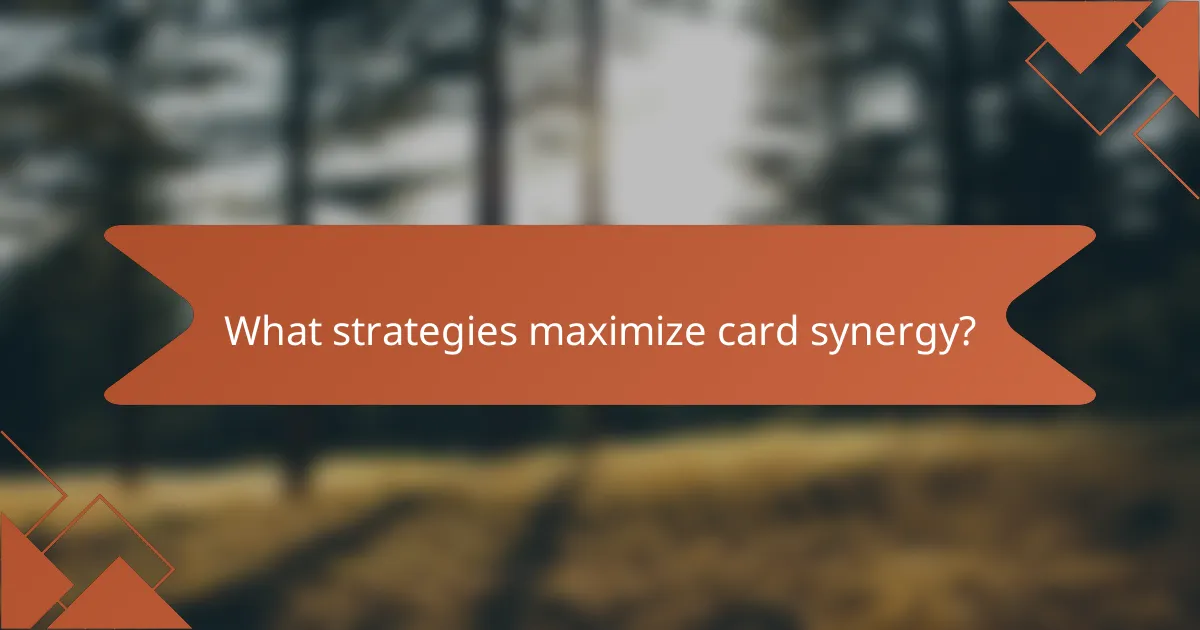Card synergy is essential for enhancing gameplay, as it allows players to create powerful combinations that maximize strengths and minimize weaknesses. By understanding how card effects interact, players can optimize their deck performance and make strategic decisions that lead to victory. Careful selection and combination of cards can significantly elevate a player’s overall effectiveness in the game.

What are effective card combinations for synergy?
Effective card combinations for synergy enhance gameplay by maximizing strengths and minimizing weaknesses. These combinations often involve cards that complement each other’s abilities, leading to powerful effects and strategic advantages.
Card A and Card B synergy
The synergy between Card A and Card B lies in their ability to amplify each other’s effects. For instance, if Card A boosts attack power, and Card B provides additional attack opportunities, using them together can significantly increase damage output.
To maximize this synergy, consider the timing of your plays. Deploy Card A first to establish a strong base, then follow up with Card B to capitalize on the enhanced attack. Avoid using them in isolation, as their combined effect is where the real power lies.
Card C and Card D synergy
Card C and Card D work well together by providing defensive and offensive capabilities simultaneously. For example, Card C might offer protection while Card D deals damage to opponents, creating a balanced strategy that can withstand attacks while retaliating effectively.
When utilizing this combination, focus on positioning. Place Card C in a defensive role to absorb hits, while Card D can be positioned to strike back. This dual approach can frustrate opponents and create openings for further attacks.
Card E and Card F synergy
The combination of Card E and Card F is powerful due to their ability to control the game state. Card E might manipulate the draw phase, while Card F can capitalize on the new cards drawn, allowing for strategic plays that can shift the momentum in your favor.
To leverage this synergy, prioritize drawing cards with Card E before playing Card F. This ensures you have the best options available. Be cautious of overcommitting to this strategy, as relying too heavily on card draw can leave you vulnerable to disruption.

How do card effects interact in gameplay?
Card effects interact in gameplay through a combination of synergies and counteractions that can enhance or hinder a player’s strategy. Understanding these interactions is crucial for optimizing deck performance and making informed decisions during play.
Positive interactions
Positive interactions occur when card effects complement each other, amplifying their overall impact. For example, a card that boosts attack power can work well with a card that allows for multiple attacks in a turn, creating opportunities for significant damage.
Another common positive interaction is between cards that generate resources and those that require them. A card that produces extra mana can enable the use of high-cost spells, maximizing the effectiveness of a player’s turn. Players should look for these synergies to build powerful combinations.
Negative interactions
Negative interactions happen when card effects conflict, leading to wasted resources or reduced effectiveness. For instance, a card that requires a specific type of resource may clash with another that alters or removes that resource type, leaving the player unable to utilize their strategy effectively.
Additionally, some cards may impose restrictions that hinder the use of others. A card that limits the number of creatures on the field can prevent a player from deploying their full strategy, creating a disadvantage. Players should be mindful of these potential conflicts when constructing their decks to avoid pitfalls.

What strategies maximize card synergy?
Maximizing card synergy involves selecting cards that complement each other to enhance overall performance. This can be achieved through careful deck-building and adjusting playstyles to leverage the strengths of your chosen cards.
Deck-building strategies
When building a deck, focus on selecting cards that share common themes or mechanics. For instance, if you choose a card that generates tokens, include additional cards that benefit from having multiple creatures on the field. This creates a cohesive strategy that amplifies your deck’s effectiveness.
Consider the mana curve as well; a balanced distribution of low, mid, and high-cost cards can ensure you have options at every stage of the game. Aim for a mix that allows for smooth gameplay, typically around 40-50% low-cost cards to maintain early-game pressure.
Playstyle adjustments
To fully utilize card synergy, adapt your playstyle to the strengths of your deck. If your cards rely on aggressive tactics, prioritize offensive moves and board control. Conversely, if your deck is built around defensive strategies, focus on stalling opponents while setting up powerful combos.
Be mindful of how your cards interact during gameplay. For example, if you have cards that trigger effects upon drawing, adjust your strategy to maximize card draw opportunities. Regularly assess your hand and board state to make informed decisions that align with your synergy goals.

What are the best digital platforms for card synergy?
The best digital platforms for card synergy include Magic: The Gathering Arena and Hearthstone, both of which offer unique mechanics and strategies for players to explore. Each platform provides distinct card interactions that can enhance gameplay and create powerful combinations.
Magic: The Gathering Arena
Magic: The Gathering Arena (MTGA) allows players to build decks using a vast array of cards, each with specific abilities that can synergize with others. Players should focus on creating a cohesive strategy by selecting cards that complement each other, such as those that boost creature abilities or enhance spell effects.
Consider the mana curve when building your deck, ensuring a balance of low, mid, and high-cost cards. For example, a deck with a strong early-game presence can pressure opponents while setting up for powerful late-game plays. Pay attention to the current meta, as certain card combinations may become more effective depending on prevalent strategies.
Hearthstone
Hearthstone emphasizes synergy through class-specific cards and mechanics, allowing players to create unique strategies based on their chosen hero. Each class has cards that work well together, so understanding these interactions is crucial for building a successful deck.
Utilize the concept of “tribes” in Hearthstone, such as Murlocs or Dragons, which can enhance the effectiveness of cards within the same category. For instance, Murloc decks can quickly overwhelm opponents with numerous low-cost creatures. Be mindful of card rotation and expansions, as these can significantly impact available synergies and strategies.

What criteria should be considered for card selection?
When selecting cards, consider factors such as rarity, type, and synergy with other cards. These criteria significantly influence a card’s effectiveness and overall strategy in gameplay.
Card rarity
Card rarity affects not only the availability of cards but also their power and potential impact on gameplay. Generally, rarer cards tend to have stronger abilities or unique effects that can turn the tide of a game.
When evaluating card rarity, consider the distribution of cards in your deck. A balanced mix of common, uncommon, and rare cards can provide versatility while maximizing your chances of drawing powerful options during play.
Card type
Card type refers to the specific category a card falls into, such as creature, spell, or artifact. Each type has distinct mechanics and roles within a game, which can greatly influence your strategy.
Understanding the strengths and weaknesses of different card types is crucial. For example, creature cards often provide ongoing board presence, while spell cards can offer immediate effects. Aim to create a deck that leverages a combination of types to enhance synergy and effectiveness.

How does card synergy evolve in competitive play?
Card synergy in competitive play evolves through the continuous interaction of strategies, player choices, and game mechanics. As players discover new combinations and tactics, the effectiveness of certain card pairings can shift, requiring constant adaptation to stay competitive.
Meta shifts
Meta shifts refer to changes in the prevailing strategies and card combinations that dominate competitive play. These shifts can occur due to new expansions, balance updates, or emerging strategies that exploit weaknesses in existing decks. For example, if a new card is introduced that counters a popular strategy, players may pivot to alternative synergies that can better withstand this change.
To stay ahead, players should regularly analyze tournament results and community discussions to identify emerging trends. Keeping track of which decks are performing well can help players anticipate shifts and adjust their own strategies accordingly.
Player adaptations
Player adaptations involve modifying deck compositions and strategies in response to evolving card synergies and meta shifts. This can include incorporating new cards that enhance existing synergies or replacing underperforming cards with alternatives that better fit the current landscape. For instance, if a previously effective combo becomes less viable, players might seek out cards that provide similar benefits or counter popular threats.
It’s crucial for players to remain flexible and open to experimentation. Regularly testing different combinations in practice matches can reveal unexpected synergies and help refine strategies before entering competitive play. Keeping a close eye on the competition and adjusting accordingly can make a significant difference in performance.
